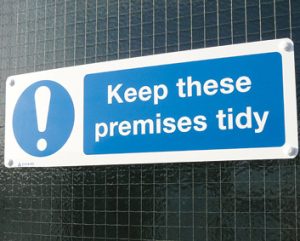 Danny Adamson, Managing Director at Stocksigns, explains the relevant requirements for workplace signage and provides guidance on ensuring compliance with UK safety regulations
Danny Adamson, Managing Director at Stocksigns, explains the relevant requirements for workplace signage and provides guidance on ensuring compliance with UK safety regulations
Creating a safer workplace for employees is crucial. According to the Health and Safety Executive (HSE), in 2023/24, there were 138 workplace fatalities in Great Britain, with three of the most common causes of fatal injuries at work being a fall from height, being struck by a moving vehicle or being struck by a moving object.
Although safety signage should never be a substitute for safe working practices, it does serve as a reminder to staff about the protocols and procedures they must take to reduce their chance of injury in the workplace and highlight any potential risk.
FOLLOWING THE REGULATIONS
Published in 1996, the Health and Safety (Signs and Signals) Regulations are applicable in England, Wales and Scotland and state that anyone who has responsibility for a premises must ensure that safety signs are in place, wherever there are significant risks to employees that cannot be controlled by other methods.
Other regulations such as the Health and Safety at Work Act 1974 also include a duty of care to members of the public.
To ensure compliance, employers must carry out risk assessments to determine what signage is required throughout a site. This includes identifying hazards, the risks the hazards present and the control measures that need to be taken to mitigate those risks. If there are still significant risks once this process has been completed, safety signs should be used to warn employees. An element of training and instruction is also required to ensure employees are aware of the signs and understand the signs’ meaning. A small amount of supplementary text alongside the sign may be useful to ensure full understanding.
SIGNAGE REQUIREMENTS
When implementing the required signage, these should be permanent (unless the workplace or hazard is temporary), durable, securely fastened and properly maintained. Visibility is also a crucial factor, as the signs must be big enough to be seen easily by employees and ensure a clear understanding, as well as showing where and what the hazard is. They should also be placed at an appropriate height, usually at eye level, taking into account any potential obstacles that may impact visibility.
 It is also important that there are not too many signs in the same space to help avoid confusion. Signs that are no longer necessary should be removed if the hazard is no longer present, to avoid presenting misleading information.
It is also important that there are not too many signs in the same space to help avoid confusion. Signs that are no longer necessary should be removed if the hazard is no longer present, to avoid presenting misleading information.
Signage incorporating pictograms, specifically those outlined in BS EN ISO 7010, are helpful, as they help to communicate warnings in an immediate and obvious manner by visually representing what the risk or hazard is clearly and consistently. Ambient lights should also be considered to illuminate important signs, especially in the case of an emergency.
UNDERSTANDING THE DIFFERENT SIGNS
There are five specific categories of safety signage, each with specific ‘intrinsic features’ to make them easier to distinguish and understand. These include colour, shape, and design to aid recognition. Although the regulations allow some variation in terms of design, the unique features must be maintained. More information about the features of each category of signage can be found in guidance documents from the HSE.
- Prohibition signs – round with red edging, a diagonal line and black pictogram: These are used to prohibit behaviours that would cause a hazard or impact health and safety. Examples include ‘No smoking’, ‘No access for unauthorised persons’ or ‘Do not touch’.
- Hazard/Warning signs – triangular with yellow background, black edging and a black pictogram: These are used to alert people to a potential hazard or danger, such as high voltage or dangerous materials.
- Mandatory signs – round with a white pictogram on a blue background: These are instructional signs, used to direct behaviour to ensure safety. For example, ‘Eye protection must be worn’.
- Fire equipment signs – rectangular or square with a white pictogram on a red background: Used to indicate the location of firefighting equipment.
- Emergency escape or first-aid signs – rectangular or square with a white pictogram on a green background: These provide information designed to enhance safety by directing people to emergency exits, first aid materials and assembly points.
SUPPLIER SUPPORT
Safety signage plays a critical role in ensuring a safe working environment when the risk from a specific hazard cannot be eliminated using other methods. However, ensuring that the correct and compliant signage is in place can be challenging, especially within a large site or if you are responsible for multiple sites. Working with an experienced signage supplier can make the task a lot easier. This includes allocating a dedicated account manager to learn the needs of your specific site, offering specialist insight and providing peace of mind that all signs are fully compliant, and all legal obligations are met.
In association with www.stocksigns.co.uk





